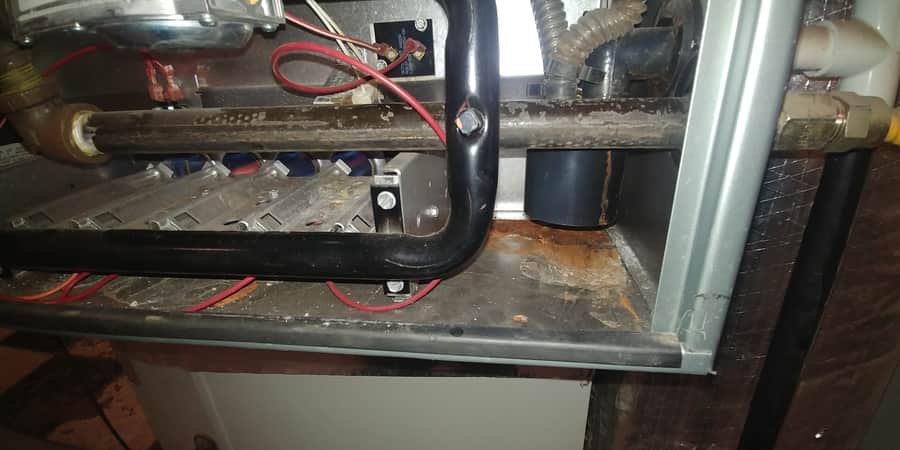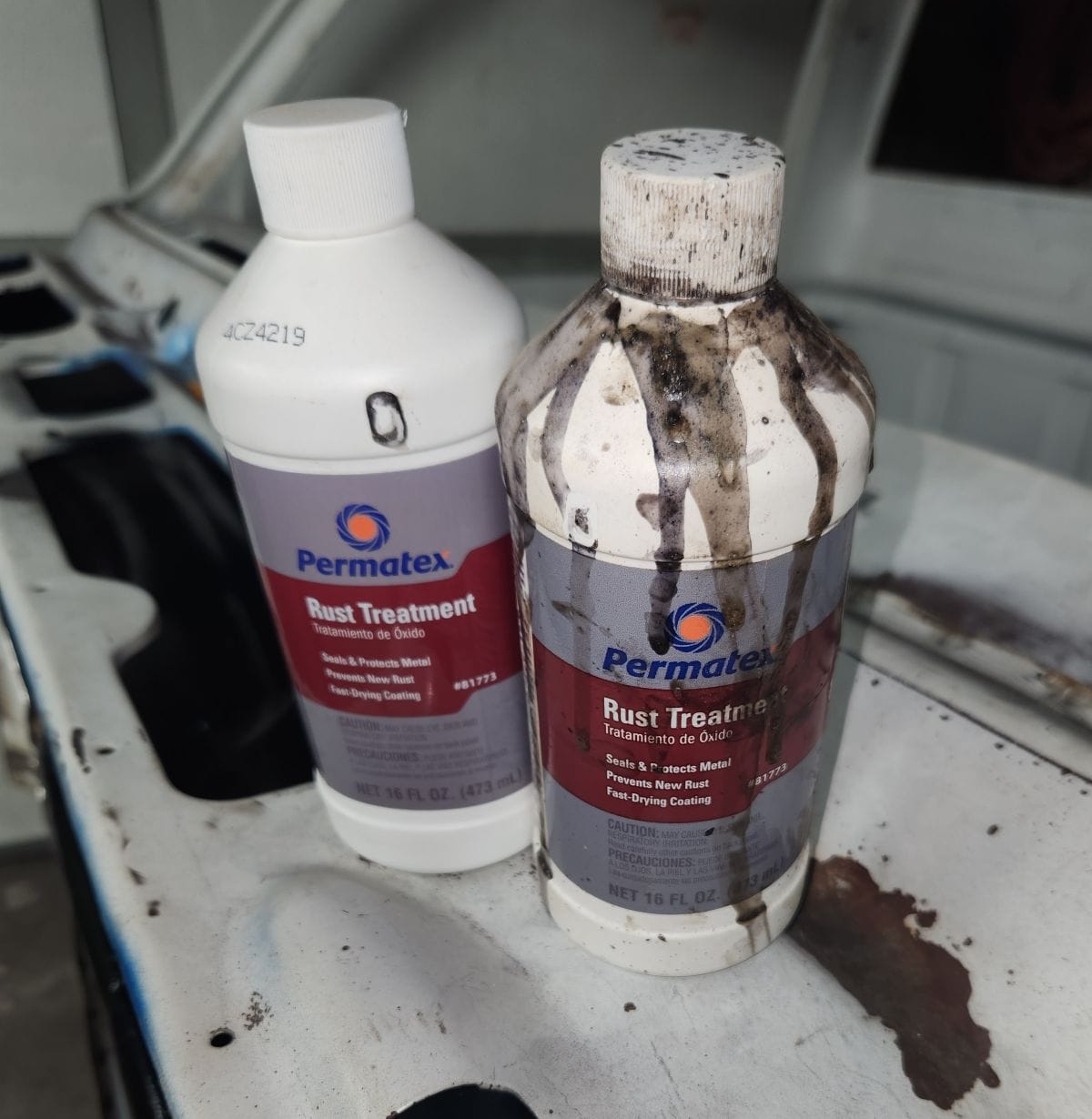Is My Gas Furnace Leaking Water In The Winter?
Last Updated on June 23, 2025 by Chad Peterson
If your gas furnace is leaking water in the winter, it’s likely a high-efficiency (90%+) model. These furnaces create condensation as a byproduct of pulling more heat from the exhaust gases. If the drainage system is clogged, damaged, or poorly installed, that water can leak out and rust the cabinet or floor below.
Not all leaks are obvious, and they don’t always come from the air conditioner. Let’s break down the causes, what to look for, and what you can do about it.
Why Is My Gas Furnace Leaking Water?
Presently, we have three basic types of gas furnaces:
- Natural draft (less than 79% efficient)
- Induced draft (79% or slightly higher)
- 90% + efficiency (recuperative furnaces)
Some gas furnaces vented into metal flue pipe called B-Vent. This double-walled pipe reduced the clearances needed in construction and provided a solution to venting where a chimney didn’t exist. B-vent heated up pretty good and water coming back down the pipe was not too common.
Water problems with gas furnaces began primarily when furnace efficiencies approached and exceeded 80%.
Most of the leaks that occurred in gas furnaces with B-vent were leaks created by a poorly caulked roof jack.
Is It Really a Furnace Leak — or the AC?
A gas furnace leaking water in summer is generally an air conditioning problem with condensation. Depending on the furnace and coil configuration, water leaking from an AC coil can appear to be leaking from the furnace.
Common Causes of Leaks in High-Efficiency Furnaces
High-efficiency furnaces create condensation, and that water has to be removed without leaking into the furnace and causing rust.
The most common leaks occur from:
- Inducer motor seals
- Overflowing condensate trap
- Loose connections in drain lines
- Cracked or clogged condensate drain
- Leaky PVC joints
Natural Draft vs. Induced Draft vs. 90%+ Furnaces
Natural Draft
The old natural draft furnaces lost 30% of the heat they created up and out of the chimney. That’s a scary thought when you consider todays energy price.
Just a side note here: You can learn more about how a gas furnace works by reading one of my articles titled How A Gas Furnace Works (A Quick Tour)
Induced Draft
Induced draft was the next innovation in saving some of that wasted heat going into the atmosphere. It was a method of tightening the heat exchanger and adding a fan called an inducer to the draft. This brought the efficiency closer to 80%.
Problems were created with those 80% furnaces when they replaced an old natural draft furnace that was connected to a brick chimney. The flue temperatures were now lower and were not hot enough to create a good draft.
Condensation would form, and that condensation was acidic, resulting in the decay of the chimney.
The only way to solve the condensation problem is to install a chimney liner. The liners come in a kit that includes a cover to seal the chimney top and a liner top cap to keep out the rain and the birds.
90%+ Furnaces
As furnace efficiencies increased, more of the heat that went up the chimney was recouped by more recuperative coils inside the furnace. The potential for leaks came with the recuperative coil and the plumbing needed to drain the condensation.
To me, it’s an amazing technology. The geniuses behind developing these higher-efficiency furnaces have gas-heating furnaces hitting 97% efficiency. Think about that for a moment. Only three percent of the heat created goes up the chimney compared to more than 20%.
How to Fix a Gas Furnace That’s Leaking Water
Always use caution when opening or removing the doors of your furnace. Wear proper clothing and protective gear. Turn off the power to the furnace.
- Open the cabinet to inspect for rust and puddling
- Check and clear the drain lines
- Inspect PVC connections
- Decide if you can DIY or call a technician
Can a Furnace Water Leak Be Dangerous?
Most of the water leaks that I have found in furnaces have just created a mess of rust and corrosion. But, some have leaked into the controls and caused the furnace to fail.
Any time water and electricity are present together, there is a potential for danger. Always turn of the power to your furnace if you decide to investigate a water leak on your own.
Remember that this water leaking in high-efficiency furnaces is very acidic and eats metal like a ravening wolf. This is the perfect storm and should be an incentive for homeowners to have yearly maintenance.
You can’t stop this rust unless it’s treated the right. Sanding, scraping, and painting will not keep this cancer from going right on through the metal.

The installer created the leak in the image above (97% efficient furnace). A poorly fitted drain pipe at the trap inside the furnace. Not all defects, especially in systems like HVAC equipment, are defects made in a factory.
So many things in a good heating and air conditioning system are dependent upon a knowledgeable installer.
I have used a product by Permatex called Rust Treatment, which is available on Amazon. It’s a simple paint-on with a brush application. Let it set for about 15 minutes, and apply a second coating. The Permatex turns a nice-looking black color, changing rust into a protective primer coating.
Permatex Rust Treatment
- Seals & Protects Metal
- Prevents New Rust
- Fast-Drying Coating
- Dries To A Hard, Black Paintable Surface
I might earn commissions on sales made via this link.

Conclusion To Why Is My Gas Furnace Leaking Water
Not only can a condensation leak rust out the inside of a furnace, but it will also etch out a concrete floor and make permanent marks in other materials if it’s leaking out a pipe joint away from the furnace.
Leaks are not always a symptom of a bad connection in the PVC or drain pipes within the furnace. Recuperative coils have been known to be defective. If the water seems to be coming from deep inside the furnace, that must be fixed.
Finding water leaks is sometimes a nightmare. Water likes to travel down the most inconspicuous places. It leads one to think the leak is in one place while it’s in a completely different location.
Hopefully, your furnace is still under warranty if it’s a 90+ efficient furnace. The repair cost for recuperative coils can be quite expensive, If your warranty is good then even the labor will be high because it incorporates almost completely dismantling the furnace to get at the coil.
You may benefit by reading an article I wrote about what questions to ask when buying a new HVAC system.



